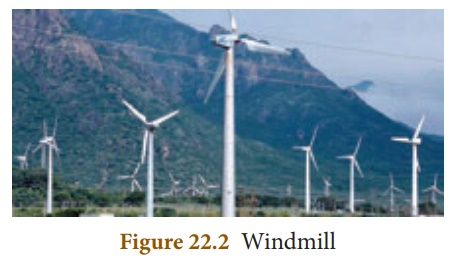Chapter: 10th Science : Chapter 22 : Environmental Management
Non-Conventional (Alternative) Energy Resources
Non-Conventional
(Alternative) Energy Resources
The energy crisis has
shown that for sustainable development in energy sector we must conserve the
non-renewable conventional resources from its rapid depletion and replace them
by non-polluting, renewable sources which are environmentally clean.
Efforts are made to
develop new sources of energy which is called non-conventional sources of
energy. It would provide greater initiative to local people who could assess
their needs and resources and plan a strategy that could be useful to them.
1. Solar Energy
Solar energy is the energy
obtained from the sun. The sun gives out vast amount of light and
heat. It is only a little less than half (47 %) of solar energy which falls on
the atmosphere reaches the earth’s surface. If we could use just a small part
of this energy it would fulfill all the country’s need for power. Solar energy has
advantages and also certain limitations.
Solar Energy Devices
The energy from the sun
can be harnessed to provide power. The various devices used for harnessing
sun’s energy are called solar energy devices.
Solar Cells
Solar cells
(Photovoltaic devices) is made up of silicon that converts sunlight directly
into electricity. Solar cell produces electricity without
polluting the environment. Since it uses no fuel other than sunlight, no
harmful gases, no burning and no wastes are produced. These can be installed in
remote and inacessible areas (forests and hilly regions) where setting up of
power plant is expensive.
Uses of Solar cells
i.
It can be used for street lighting, traffic signals, water
pumping, battery charging system etc.
ii.
It is used in artificial satellites and space probes
iii.
It provides radio and TV transmission to remote areas
Solar Panel
Arrangement of many
solar cells side by side connected to each other is called solar panel. The
capacity to provide electric cuurent is much increased in the solar panel. But
the process of manufacture is very expensive.

Solar Cooker
It consist of an
insulated metal box or wooden box which is painted from inside so as to absorb maximum
solar radiations. A thick glass sheet forms the cover over the box. The
reflector is the plane mirror which is attached to the box. The food is cooked
by energy radiated by the sun.

Solar thermal power plant
In solar thermal power
plants, many solar panels are used to concentrate sun rays, to heat up water
into steam. The steam is used to run the turbines to produce electricity.
Advantages of Solar Energy
i.
It is available in abundance in our country and is free of cost.
ii.
It is a renewable source of energy.
iii.
It can be used for generating electricity or heat.
iv. It does not cause pollution.
2. Biogas
Biogas is the mixture of
methane (nearly 75 %), hydrogen sulphide, carbon dioxide and hydrogen. It is
produced by the decomposition of animal wastes (cow dung) and
plant wastes in the absence of oxygen. It is also commonly called as ‘Gobar
gas’ since the starting material used is cow dung which means gobar in
Hindi.
Uses of biogas
i.
It is used as fuel for cooking .
ii.
It is used to run motors and pump sets.
iii.
It is used to generate electricity.
Advantages of biogas
i.
It burns without smoke and therefore causes less pollution.
ii.
An excellent way to get rid of organic wastes like bio-waste and
sewage material.
iii.
eft over slurry is a good manure rich in nitrogen and phosphorus
iv.
It is safe and convenient to use
v.
It can reduce the amount of greenhouse gases emitted.
3. Shale gas
Shale refers to the soft
finely stratified sedimentary rock that is formed from the compaction
of small old rocks containing mud and minerals – such as quartz and calcite,
trapped beneath earth’s surface. These rocks contain fossil fuels like oil and
gas in their pores.
The fuel is extracted by
a technique called hydraulic fracturing (drilling or well boring of
sedimentary rocks layers to reach productive reservoir layers).
Environmental concerns of shale gas
i.
Shale drilling could affect groundwater reserves, which can
contaminate the drinking water resources and also affect the fertility of the
soil.
ii.
Million gallons of water is needed to break and release the shale
gas, which inturn can affect the water table.
4. Wind Energy
The kinetic energy
possessed by the wind is due to its high speed, that can be converted into
mechanical power by wind turbines. The wind energy can be used for
(i) generating electricity (ii) Run water pumps, flour mills etc. (iii)
Rotatory motion of windmill is used to draw water from wells.
Windmill

Windmill is a machine
that converts the energy of wind into rotational energy by broad blade attached
to the rotating axis. When the blowing air strikes the blades of the windmill,
it exerts force and causes the blades to rotate. The rotational movement of the
blades operate the generator and the electricity is produced. The energy output
from each windmill is coupled together to get electricity on a commercial
scale.

Advantages of Wind energy
i.
Wind energy is free, eco-friendly, renewable source of energy.
ii.
It does not cause pollution.
iii.
Expenses on periodic maintenance is low when compared to the other
power sources.
5. Water Energy
Earth’s surface is
covered with nearly 71 % of water. Harnessing the energy from the flowing
water can be used to produce electricity. The technique to harness
the water energy is called Hydropower.
The electrical energy is
derived from water flow, water falling from a height. Hilly areas are suitable
for this purpose where there is continous flow of water in large amounts
falling from high slopes. It does not cause environmental pollution or waste
generation.
Hydropower plants converts the kinetic energy
of flowing water into electricity. This is called hydroelectricity.
6. Tidal Energy
Tidal energy is the energy
obtained from the movement of water due to ocean tides. Tides
are the rise and fall of sea levels caused by the combined effects of the gravitational
forces exerted on the oceans of the earth.
A tidal stream is a fast
flowing body of water created by tides. Turbines are placed in tidal streams.
When the tides hit the turbine, the turbine rotates and converts the tidal
energy into electric energy
Advantages of tidal
energy
i.
Tidal energy does not produce any pollution.
ii.
It does not use any fuel and does not produce any waste.
iii.
Tides are predictable, so tidal energy can be produced at any
time.
iv.
Water is denser than air and therefore can generate electricity at
lower speeds than wind turbines.
Related Topics